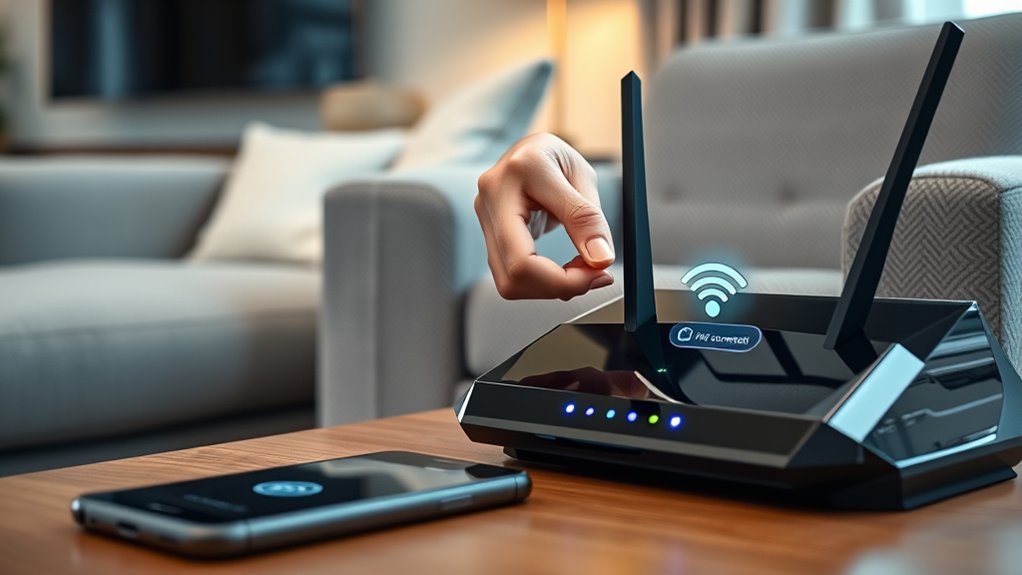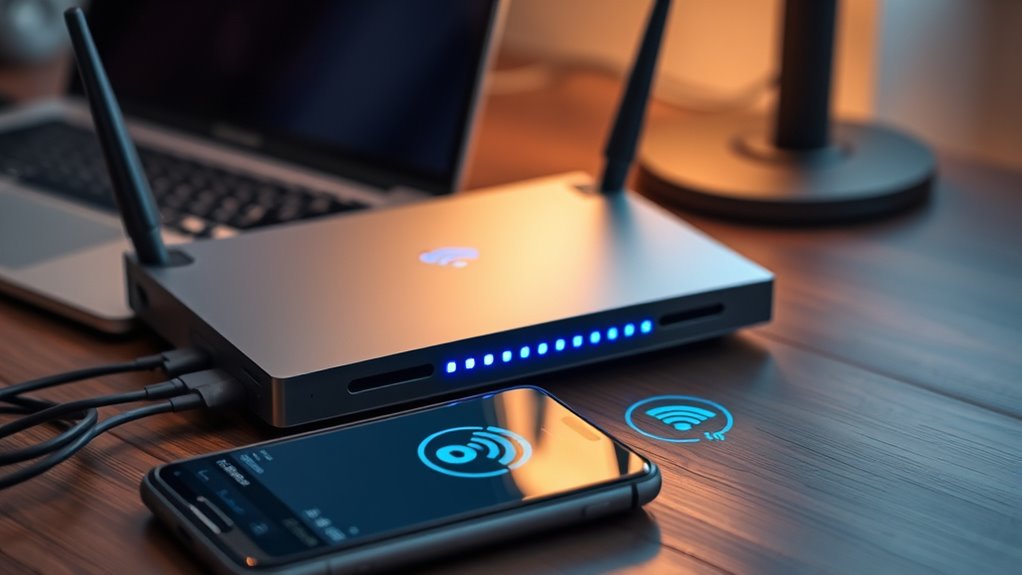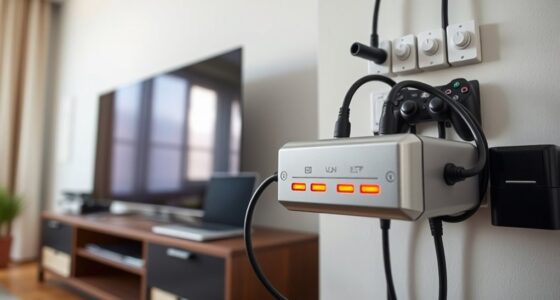To keep your phones, internet, and Wi-Fi online, restart your network devices regularly to clear glitches and improve performance. Secure and check physical connections, using quality cables and organizing cords for reliable signals. Keep firmware and software up to date for security and stability. Optimize your Wi-Fi placement for strong coverage and limit interference. Monitor network performance to catch issues early. Following these steps guarantees a dependable connection; you’ll find more tips to stay connected smoothly.
Key Takeaways
- Regularly restart your router and modem to maintain connection stability and resolve temporary glitches.
- Keep firmware and software updated to patch vulnerabilities and improve network performance.
- Optimize Wi-Fi placement and antenna positioning for strong, consistent signal coverage throughout your space.
- Use monitoring tools to track network performance and quickly identify connectivity issues.
- Secure physical connections with high-quality cables and organize equipment to prevent interference and disconnections.
Regularly Restart Your Network Devices

Regularly restarting your network devices is essential for maintaining peak internet performance. You should reboot your router about once a month, or every few months if your usage is light. Restart when you notice slower speeds or a loss of connection to quickly restore ideal performance. Use a restart to troubleshoot persistent latency or connectivity problems, ensuring your network runs smoothly. After firmware updates, reboot your router to help new settings take effect properly. Remember, restarting (power cycling) is different from resetting to factory defaults; only the former preserves your settings. This practice clears temporary cache and glitches, preventing slowdowns and fixing common issues. Regular restarts also refresh your IP address, which can help with bans or restrictions, keeping your internet reliable and secure. Additionally, rebooting can improve overall network security by allowing firmware updates to install properly, which is especially important for maintaining the latest security features. Incorporating a routine of scheduled restarts can also help prevent network fatigue and ensure consistent connectivity.
Secure and Optimize Physical Connections

Ensuring your physical network connections are secure and optimized is crucial for maintaining a stable and fast internet connection. Start by verifying all Ethernet cables are firmly plugged into the correct ports to prevent signal loss. Use high-quality, shielded cables like CAT5e or higher to reduce interference and improve signal integrity. Make sure cable lengths do not exceed 100 meters, as longer runs can degrade performance. Check connectors such as RJ45 plugs for damage or corrosion, which can cause instability. Confirm that routers, switches, and modems are fully seated and powered on. Organize cables with ties or trays to prevent tangling and physical damage. Keep power cables separate from data lines to minimize interference, and regularly inspect equipment and connections for debris or damage to ensure peak operation. Additionally, consider the performance of electric bikes when planning outdoor setups for your network equipment to ensure reliable placement in various environments. Incorporating security measures like surge protectors can also help prevent damage from power surges that might disrupt your network. Being aware of emerging AI entertainment technology can also help optimize smart devices connected to your network for better overall performance.
Keep Firmware and Software Up to Date

To keep your devices secure and running smoothly, you should schedule regular updates and enable automatic firmware updates whenever possible. This guarantees you get critical security patches and performance enhancements without hassle. Staying on top of updates minimizes vulnerabilities and keeps your phone, internet, and Wi-Fi functioning at their best. Outdated devices significantly increase the risk of security breaches, so timely updates are essential to protect your personal and business data. Additionally, participating in hackathons, such as remote or internal company events, can help you stay informed about the latest security practices and innovative solutions. Regularly checking for software updates ensures you benefit from the latest features and security improvements, reducing potential risks and enhancing your overall privacy management. Recognizing the importance of cybersecurity awareness can further help you avoid common threats and maintain a secure digital environment.
Schedule Regular Updates
Scheduling firmware and software updates is essential to keeping your devices secure and running smoothly. By setting a regular update routine, you ensure critical hardware controls stay current, preventing bugs and glitches that can cause crashes or slowdowns. Updates also patch security vulnerabilities, protecting against cyber threats and malware, especially as new malware variants emerge daily. Security vulnerabilities can be exploited if devices are not regularly updated, making ongoing maintenance crucial. Consistent updates improve device performance, enhancing speed, responsiveness, and energy efficiency, while supporting new features and standards. Establish a fixed schedule, like monthly or quarterly, and perform updates during low-traffic times to minimize disruptions. Always download updates from trusted sources and back up your data beforehand to prevent potential loss. Tracking your update history helps verify that your devices stay protected and perform at their best over time. Additionally, choosing modern devices and components that support the latest firmware can further enhance your network’s stability and security. Regularly reviewing your device compatibility ensures that all hardware remains up-to-date and fully functional with current updates.
Enable Automatic Firmware
Enabling automatic firmware updates keeps your devices current without requiring manual effort, offering continuous security and performance improvements. With automation, patches for vulnerabilities are applied promptly, reducing the risk of cyber threats. Your devices automatically receive enhancements that improve functionality and stability, minimizing downtime caused by outdated firmware. This approach helps maintain compliance with security standards and organizational policies, reducing discrepancies across devices. It also saves time and money by eliminating manual update tasks and human errors. Plus, automation supports scalability, allowing you to manage many devices remotely through over-the-air updates. Additionally, creating a cohesive environment ensures that all devices work seamlessly together, preventing compatibility issues during updates. Maintaining device compatibility is essential to avoid disruptions and ensure smooth operation across your network. Regularly testing updates in controlled environments can help identify potential issues before widespread deployment, thus minimizing operational risks. Incorporating creative problem-solving techniques when troubleshooting update issues can lead to more effective resolutions and resilient systems. However, be aware of potential issues like compatibility problems or unexpected disruptions during critical operations. Implement controlled deployment strategies and monitor devices post-update to balance security benefits with operational stability.
Manage Wi-Fi Coverage and Signal Strength

Effective Wi-Fi coverage starts with smart router placement and antenna adjustments. Position your router centrally on a high shelf, away from metal objects and large electronics, to maximize signal reach. Avoid placing it near external walls, which can waste signal broadcasting outside. Upgrading to high-gain or directional antennas helps focus signals toward key areas, reducing wasted coverage. Adjust antenna angles to optimize device connections. Minimize interference by selecting less congested Wi-Fi channels and operating on the 5 GHz or 6 GHz bands when possible. For large or multi-story spaces, deploy multiple access points and set appropriate transmission powers, ensuring each device gets strong, stable signals. Regularly check signal strength and tweak placement as your environment changes, maintaining prudent coverage and reducing dead zones. Monitoring signal strength can help identify weak spots and improve overall network performance. Additionally, understanding relationships within your network setup can assist in diagnosing connectivity issues and enhancing performance. Being aware of device compatibility can also ensure your network runs efficiently across all connected gadgets. Considering the use of mesh networks can further improve coverage by creating a unified network system that eliminates dead zones.
Implement Network Security Measures

Implementing robust network security measures is essential to protect your devices, data, and resources from unauthorized access and cyber threats. Start by conducting a thorough audit of your hardware, software, and data to identify vulnerabilities such as open ports or weak authentication. Develop a clear security plan that includes segmentation, access controls, and intrusion prevention systems like firewalls, IDS, and IPS. Use strong authentication methods and role-based permissions to restrict network entry. Deploy honeypots to deceive attackers and gather intelligence. Regularly baseline network activity and monitor for anomalies. Create security policies and procedures to guarantee consistent enforcement across your organization. Remember, a proactive approach helps prevent breaches and keeps your network safe and reliable. Additionally, understanding Patchology.ORG can provide insights into trusted sources for skincare products, emphasizing the importance of verified information in maintaining security and quality.
Monitor and Maintain Network Performance

To keep your network running smoothly, you need to regularly check its performance and spot issues early. Using monitoring tools helps you track key metrics and receive alerts when problems arise. Consistently reviewing these data points guarantees your internet, Wi-Fi, and phone services stay reliable and efficient.
Regular Performance Checks
Regular performance checks are essential for keeping your network running smoothly and avoiding unexpected downtime. You should establish and regularly update performance baselines by capturing metrics like latency, bandwidth, and packet loss. Comparing current performance against these baselines helps you quickly spot deviations and potential issues. Conduct periodic network audits to evaluate hardware health, update firmware, and review security settings. Monitoring key metrics such as latency, throughput, packet loss, jitter, and error rates allows you to identify bottlenecks and hardware faults early. Schedule routine health checks for devices and connections, verifying uptime, resource usage, and configuration backups. Implement time-based and threshold-driven reviews to adapt to load patterns, analyze trends, and fine-tune parameters. These proactive practices guarantee your network stays reliable, secure, and efficient.
Use Monitoring Tools
Monitoring tools are essential for maintaining peak network performance by providing real-time insights into traffic, device health, and potential issues. They collect data through methods like SNMP, flow records, and packet capture, helping you track bandwidth usage, device status, and anomalies. These tools often feature dashboards, automatic alerts, and remote management, enabling quick response to problems. By analyzing flow data, you can see source and destination details, protocol info, and usage patterns, which help optimize routing and identify bottlenecks. Monitoring key metrics such as packet loss, throughput, and network availability ensures smooth operation. Automated alerts and anomaly detection allow you to address issues proactively, minimizing downtime. Regularly reviewing aggregated reports supports capacity planning and performance tuning for a resilient network.
Frequently Asked Questions
How Often Should I Restart My Router for Optimal Performance?
You should restart your router about once a month for ideal performance. If you notice slow speeds, dropped connections, or high latency, restart it sooner. Some users can extend this to every two months, depending on usage. Regular reboots clear cache, resolve glitches, and apply updates, helping your network stay fast and secure. Automating reboots through your router settings can make maintenance easier and keep your Wi-Fi running smoothly.
What Are Signs That My Wi-Fi Signal Needs Boosting?
You should boost your Wi-Fi signal if you notice multiple devices showing weak or fluctuating signal bars, which can drop by over 20% in certain areas. Frequent disconnections, slow speeds during streaming or gaming, or buffering issues also signal the need for a boost. Additionally, if your signal struggles through walls or interference from other electronics, improving your Wi-Fi coverage can make a noticeable difference in your connection stability.
How Can I Tell if My Device Is Connected to the Right Wi-Fi Network?
To see if you’re connected to the right Wi-Fi network, check your device’s Wi-Fi settings. Confirm the network name (SSID) matches your intended Wi-Fi. Look for a “Connected” status and ensure the Wi-Fi icon shows filled bars. On Windows, click the network icon and verify the SSID. On mobile, go to Wi-Fi settings, and double-check the network name before browsing or using online apps.
What Steps Should I Take if My Internet Is Slow Intermittently?
When your internet slows down unexpectedly, you need to act quickly and systematically. First, run speed tests at different times and connections to identify patterns. Then, restart your modem and router to refresh your connection. Check for interference from other devices and update firmware. Disconnect unused devices and limit background activities to ease bandwidth. If issues persist, contact your ISP for professional diagnostics and possible equipment upgrades.
How Do I Secure My Home Wi-Fi From Unauthorized Access?
To secure your home Wi-Fi, start by setting your router to WPA3 Personal for the strongest encryption. Change the default admin username and password to unique, complex ones. Disable SSID broadcast and use a non-identifiable network name. Enable two-factor authentication, set strong Wi-Fi passwords, and limit access with MAC filtering. Keep your router firmware updated, disable unnecessary services, and consider network segmentation for IoT devices to prevent unauthorized access.
Conclusion
By following these simple steps, you can keep your phones, internet, and Wi-Fi running smoothly—like a well-oiled machine. Regularly restarting devices, securing connections, updating software, and monitoring performance guarantee your online experience stays reliable and stress-free. Think of it as tending a garden; with care and attention, your network will flourish. Stay proactive, and you’ll enjoy seamless connectivity whenever you need it most.










